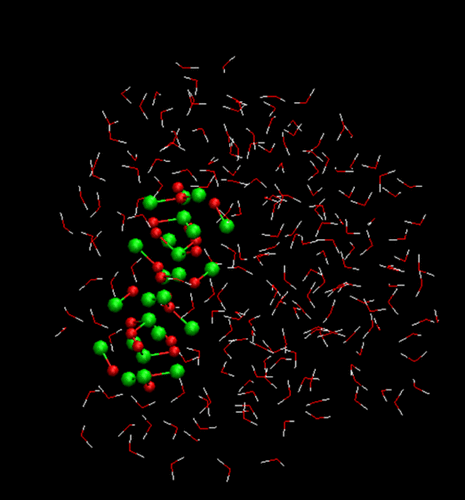Our official English website, www.x-mol.net, welcomes your
feedback! (Note: you will need to create a separate account there.)
Hydrate Nucleation, Growth, and Induction.
ACS Omega ( IF 3.7 ) Pub Date : 2020-02-04 , DOI: 10.1021/acsomega.9b02865 Bjørn Kvamme 1 , Solomon Aforkoghene Aromada 2 , Navid Saeidi 3 , Thomas Hustache-Marmou 4 , Petter Gjerstad 2
ACS Omega ( IF 3.7 ) Pub Date : 2020-02-04 , DOI: 10.1021/acsomega.9b02865 Bjørn Kvamme 1 , Solomon Aforkoghene Aromada 2 , Navid Saeidi 3 , Thomas Hustache-Marmou 4 , Petter Gjerstad 2
Affiliation

|
The first stage of any phase transition is a dynamic coupling of transport processes and thermodynamic changes. The free energy change of the phase transition must be negative and large enough to also overcome the penalty work needed for giving space to the new phase. The transition from an unstable situation over to a stable growth is called nucleation. Hydrate formation nucleation can occur along a variety of different routes. Heterogeneous formation on the interface between gas (or liquid) and water is the most commonly studied. A hydrate can also form homogeneously from dissolved hydrate formers in water, and the hydrate can nucleate toward mineral surfaces in natural sediments or a pipeline (rust). A hydrate particle's critical size is the particle size needed to enter a region of stable growth. These critical sizes and the associated nucleation times are nanoscale processes. The dynamics of the subsequent stable growth can be very slow due to transport limitations of hydrate-forming molecules and water across hydrate films. Induction times can be defined as the time needed to reach a visible hydrate. In the open literature, these induction times are frequently misinterpreted as nucleation times. Additional misunderstandings relate to the first and second laws of thermodynamics and the number of independent thermodynamics variables. It is not possible to reach thermodynamic equilibrium in systems where hydrates form in a pipeline or in sediments. Finally, there are common misconceptions that only one type of hydrate will form. In a non-equilibrium situation, several hydrates will form, depending on which phases the hydrate formers and water come from. In this paper, we utilize a simple nucleation theory to illustrate nucleation and growth of some simple hydrates in order to illustrate the non-equilibrium nature of hydrates and the fast nucleation times. To illustrate this, we apply thermodynamic conditions for a real pipeline transporting natural gas from Norway to Germany. This specific example also serves as a case for illustration of the possible impact of rusty pipeline surfaces in kicking out water from the gas. Specifically, we argue that the tolerance limit for water concentration according to current industrial hydrate risk practice might overestimate the tolerance by a factor of 20 as compared to tolerance concentration based on adsorption on rust.
中文翻译:

水合物成核,生长和诱导。
任何相变的第一阶段都是传输过程与热力学变化的动态耦合。相变的自由能变化必须为负,并且必须足够大,以克服为新相提供空间所需的代价工作。从不稳定的情况过渡到稳定的增长被称为成核。水合物形成成核可沿多种不同途径发生。气体(或液体)与水之间的界面上的非均相形成是最常研究的。水合物还可以由水中溶解的水合物形成剂均匀地形成,并且水合物可以向天然沉积物或管道(锈)中的矿物表面成核。水合物颗粒的临界尺寸是进入稳定生长区域所需的颗粒尺寸。这些临界尺寸和相关的成核时间是纳米级过程。由于水合物形成分子和水跨水合物膜的传输限制,后续稳定生长的动力学可能非常缓慢。诱导时间可以定义为达到可见水合物所需的时间。在公开文献中,这些诱导时间经常被误解为成核时间。其他误解与热力学的第一定律和第二定律以及独立的热力学变量的数量有关。在管道或沉积物中形成水合物的系统中,不可能达到热力学平衡。最后,人们通常会误以为只会形成一种水合物。在非平衡情况下,会形成多种水合物,取决于水合物形成剂和水来自哪个相。在本文中,我们利用简单的成核理论来说明一些简单水合物的成核和生长,以说明水合物的非平衡性质和快速成核时间。为了说明这一点,我们将热力学条件应用于一条将天然气从挪威运往德国的实际管道。此特定示例还用作说明生锈的管道表面从气体中排出水时可能产生的影响的案例。具体而言,我们认为,与基于锈吸附的公差浓度相比,根据当前的工业水合物风险实践,对水浓度的公差极限可能会将公差高估20倍。我们利用简单的成核理论来说明一些简单水合物的成核和生长,以说明水合物的非平衡性质和快速成核时间。为了说明这一点,我们将热力学条件应用于一条将天然气从挪威运往德国的实际管道。此特定示例还用作说明生锈的管道表面从气体中排出水时可能产生的影响的案例。具体而言,我们认为,与基于锈吸附的公差浓度相比,根据当前的工业水合物风险实践,对水浓度的公差极限可能会将公差高估20倍。我们利用简单的成核理论来说明一些简单水合物的成核和生长,以说明水合物的非平衡性质和快速成核时间。为了说明这一点,我们将热力学条件应用于一条将天然气从挪威运往德国的实际管道。此特定示例还用作说明生锈的管道表面从气体中排出水时可能产生的影响的案例。具体而言,我们认为,与基于锈吸附的公差浓度相比,根据当前工业水合物风险实践,水浓度的公差极限可能会将公差高估20倍。为了说明这一点,我们将热力学条件应用于一条将天然气从挪威运往德国的实际管道。此特定示例还用作说明生锈的管道表面从气体中排出水时可能产生的影响的案例。具体而言,我们认为,与基于锈吸附的公差浓度相比,根据当前的工业水合物风险实践,对水浓度的公差极限可能会将公差高估20倍。为了说明这一点,我们将热力学条件应用于一条将天然气从挪威运往德国的实际管道。此特定示例还用作说明生锈的管道表面从气体中排出水时可能产生的影响的案例。具体而言,我们认为,与基于锈吸附的公差浓度相比,根据当前的工业水合物风险实践,对水浓度的公差极限可能会将公差高估20倍。
更新日期:2020-02-18
中文翻译:

水合物成核,生长和诱导。
任何相变的第一阶段都是传输过程与热力学变化的动态耦合。相变的自由能变化必须为负,并且必须足够大,以克服为新相提供空间所需的代价工作。从不稳定的情况过渡到稳定的增长被称为成核。水合物形成成核可沿多种不同途径发生。气体(或液体)与水之间的界面上的非均相形成是最常研究的。水合物还可以由水中溶解的水合物形成剂均匀地形成,并且水合物可以向天然沉积物或管道(锈)中的矿物表面成核。水合物颗粒的临界尺寸是进入稳定生长区域所需的颗粒尺寸。这些临界尺寸和相关的成核时间是纳米级过程。由于水合物形成分子和水跨水合物膜的传输限制,后续稳定生长的动力学可能非常缓慢。诱导时间可以定义为达到可见水合物所需的时间。在公开文献中,这些诱导时间经常被误解为成核时间。其他误解与热力学的第一定律和第二定律以及独立的热力学变量的数量有关。在管道或沉积物中形成水合物的系统中,不可能达到热力学平衡。最后,人们通常会误以为只会形成一种水合物。在非平衡情况下,会形成多种水合物,取决于水合物形成剂和水来自哪个相。在本文中,我们利用简单的成核理论来说明一些简单水合物的成核和生长,以说明水合物的非平衡性质和快速成核时间。为了说明这一点,我们将热力学条件应用于一条将天然气从挪威运往德国的实际管道。此特定示例还用作说明生锈的管道表面从气体中排出水时可能产生的影响的案例。具体而言,我们认为,与基于锈吸附的公差浓度相比,根据当前的工业水合物风险实践,对水浓度的公差极限可能会将公差高估20倍。我们利用简单的成核理论来说明一些简单水合物的成核和生长,以说明水合物的非平衡性质和快速成核时间。为了说明这一点,我们将热力学条件应用于一条将天然气从挪威运往德国的实际管道。此特定示例还用作说明生锈的管道表面从气体中排出水时可能产生的影响的案例。具体而言,我们认为,与基于锈吸附的公差浓度相比,根据当前的工业水合物风险实践,对水浓度的公差极限可能会将公差高估20倍。我们利用简单的成核理论来说明一些简单水合物的成核和生长,以说明水合物的非平衡性质和快速成核时间。为了说明这一点,我们将热力学条件应用于一条将天然气从挪威运往德国的实际管道。此特定示例还用作说明生锈的管道表面从气体中排出水时可能产生的影响的案例。具体而言,我们认为,与基于锈吸附的公差浓度相比,根据当前工业水合物风险实践,水浓度的公差极限可能会将公差高估20倍。为了说明这一点,我们将热力学条件应用于一条将天然气从挪威运往德国的实际管道。此特定示例还用作说明生锈的管道表面从气体中排出水时可能产生的影响的案例。具体而言,我们认为,与基于锈吸附的公差浓度相比,根据当前的工业水合物风险实践,对水浓度的公差极限可能会将公差高估20倍。为了说明这一点,我们将热力学条件应用于一条将天然气从挪威运往德国的实际管道。此特定示例还用作说明生锈的管道表面从气体中排出水时可能产生的影响的案例。具体而言,我们认为,与基于锈吸附的公差浓度相比,根据当前的工业水合物风险实践,对水浓度的公差极限可能会将公差高估20倍。











































 京公网安备 11010802027423号
京公网安备 11010802027423号